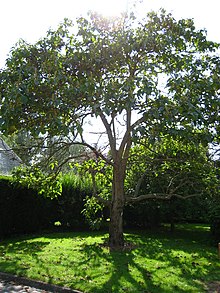
Back بولفينية (نبات) Arabic شجرة الپولونيا ARZ Pavlovniya Azerbaijani Paulownia Byelorussian Пауловния Bulgarian Paulovnija BS Paulownia CEB Pavlovnie Czech Kejsertræ-slægten Danish Paulownien German
| Paulownia | |
|---|---|

| |
| Scientific classification | |
| Kingdom: | Plantae |
| Clade: | Tracheophytes |
| Clade: | Angiosperms |
| Clade: | Eudicots |
| Clade: | Asterids |
| Order: | Lamiales |
| Family: | Paulowniaceae |
| Genus: | Paulownia Siebold & Zucc. |
| Species | |
|
Six to 17 species, including: | |
Paulownia (/pɔːˈloʊniə/ paw-LOH-nee-ə) is a genus of seven to 17 species of hardwood trees (depending on taxonomic authority) in the family Paulowniaceae, the order Lamiales. The genus and family are native to east Asia and are widespread across China.[1] The genus, originally Pavlovnia but now usually spelled Paulownia, was named in honour of Anna Pavlovna, queen consort of The Netherlands (1795–1865), daughter of Tsar Paul I of Russia. It is also called "princess tree" for the same reason.[2]
It was originally sought after as an exotic ornamental tree in Europe and Asia, and later introduced to North America in 1844. Its fruits (botanically capsules) were also used as packaging material for goods shipped from East Asia to North America, leading to Paulownia groves where they were dumped near major ports. The tree has not persisted prominently in US gardens, in part due to its overwintering brown fruits that some consider ugly.[3] In some areas it has escaped cultivation and is found in disturbed plots. Some US authorities consider the genus an invasive species,[4] but in Europe, where it is also grown in gardens, it is not regarded as invasive.
Paulownia trees produce as many as 20 million tiny seeds per year. However, the seeds are very susceptible to soil biota and only colonize well on sterile soils (such as after a high temperature wildfire). Well-drained soil is also essential. Successful plantations usually purchase plants that have been professionally propagated from root cuttings or seedlings.[5] Although seeds, seedlings, and roots of even mature trees are susceptible to rot, the wood is not and is used for boat building and surfboards.
Dimensionally stable and given its straight grain and light weight, Paulownia timber is extremely easy to work with and is reported to be resistant to decay, with decent weathering.[6]
Trees can grow to maturity in under 10 years and produce strong, lightweight timber, good as firewood, with an even higher strength to weight ratio than balsa wood.[7] Its density is low at around 0.28 kilograms per liter (2.8 lb/imp gal),[8][7][9] although significantly higher than balsa's very low 0.16 kilograms per liter (1.6 lb/imp gal).[10][11]
- ^ Barton, I.L.; Nicholas, I.D.; Ecroyd, C.E. (2007). "Pawlonia" (PDF). Forest Research Bulletin. 231.
- ^ Rush Industries, 2000.
- ^ Hu, Shiu-Ying (1961). "The Economic Botany of the Paulownias". Economic Botany. 15 (1 (Jan. - Mar., 1961)): 11–27. doi:10.1007/BF02906759. S2CID 40567325.
- ^ "Paulownia tomentosa". www.tsusinvasives.org. Retrieved 2019-12-20.
- ^ Cultivation of Paulownia - 3. Sexual & Asexual Propagation Archived 2021-10-27 at the Wayback Machine www.kalliergeia.com, accessed 20 May 2020
- ^ characteristics
- ^ a b "Paulownia | The Wood Database - Lumber Identification (Hardwood) Common Name(s): Paulownia, Royal Paulownia, Princess Tree, Kiri". Retrieved 2019-12-20.
- ^ Koman, Szabolcs; Feher, Sandor (1 March 2020). "Physical and mechanical properties of Paulownia clone in vitro 112". European Journal of Wood and Wood Products. 78 (2): 421–423. doi:10.1007/s00107-020-01497-x. S2CID 211028012.
- ^ "Physical and mechanical properties of paulownia tomentosa wood planted in hungaria". ResearchGate.
- ^ "Balsa | WoodSolutions". www.woodsolutions.com.au.
- ^ Borrega, Marc; Ahvenainen, Patrik; Serimaa, Ritva; Gibson, Lorna (1 March 2015). "Composition and structure of balsa (Ochroma pyramidale) wood". Wood Science and Technology. 49 (2): 403–420. doi:10.1007/s00226-015-0700-5. hdl:1721.1/102327. S2CID 6546811.